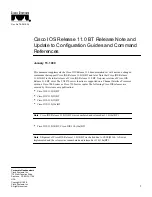
Inside Local Addresses
The
inside local
address is a configured IP address that is assigned to a host on the inside
network. Addresses may be globally unique (not requiring translation), allocated from
the private address space defined in RFC 1918, or officially allocated to some other
organization.
Inside Global Addresses
The
inside global
address is the
translated
IP address of an inside host as seen by an
outside host and network. Addresses may be allocated from a globally unique address
space (often provided by the ISP, if the inside address is connected to the global Internet).
Outside Local Addresses
The
outside local
address is the
translated
IP address of an outside host as it appears to
the inside network. Addresses may be globally unique (not requiring translation), allocated
from the private address space defined in RFC 1918, or officially allocated to some other
organization.
Outside Global Addresses
The
outside global
address is the configured, publicly routable IP address assigned to a
host on the outside network.
Understanding Address Translation
Address translation can occur one of two ways: inside or outside source translation.
Inside Source Translation
Inside source translation is the most commonly used NAT configuration. When an inside
host sends a packet to the outside network, the NAT router translates the source
information (either the source address or the source address/port pair) and, in the inbound
direction, restores the original information (this time operating on the destination address
or address/port pair).
For outbound traffic, the NAT router translates the inside local address (or address/port)
into the inside global address (or address/port), either through a statically defined
translation or dynamically created translation. For inbound traffic, a translation must be
found to revert the inside global address (or address/port) into the inside local address
(or address/port), or the packet is not routed into the inside network.
NOTE:
Dynamic inside source translations are established by outbound traffic.
You use inside source translation in traditional and bidirectional NAT configurations.
Outside Source Translation
Outside source translation is used in NAT configurations only when addresses of external
hosts might create a conflict on the private network. This complementary translation
65
Copyright © 2010, Juniper Networks, Inc.
Chapter 2: Configuring NAT
Summary of Contents for JUNOSE 11.2.X IP SERVICES
Page 6: ...Copyright 2010 Juniper Networks Inc vi...
Page 8: ...Copyright 2010 Juniper Networks Inc viii JunosE 11 2 x IP Services Configuration Guide...
Page 18: ...Copyright 2010 Juniper Networks Inc xviii JunosE 11 2 x IP Services Configuration Guide...
Page 22: ...Copyright 2010 Juniper Networks Inc xxii JunosE 11 2 x IP Services Configuration Guide...
Page 28: ...Copyright 2010 Juniper Networks Inc 2 JunosE 11 2 x IP Services Configuration Guide...
Page 116: ...Copyright 2010 Juniper Networks Inc 90 JunosE 11 2 x IP Services Configuration Guide...
Page 144: ...Copyright 2010 Juniper Networks Inc 118 JunosE 11 2 x IP Services Configuration Guide...
Page 230: ...Copyright 2010 Juniper Networks Inc 204 JunosE 11 2 x IP Services Configuration Guide...
Page 262: ...Copyright 2010 Juniper Networks Inc 236 JunosE 11 2 x IP Services Configuration Guide...
Page 294: ...Copyright 2010 Juniper Networks Inc 268 JunosE 11 2 x IP Services Configuration Guide...
Page 328: ...Copyright 2010 Juniper Networks Inc 302 JunosE 11 2 x IP Services Configuration Guide...
Page 345: ...PART 2 Index Index on page 321 319 Copyright 2010 Juniper Networks Inc...
Page 346: ...Copyright 2010 Juniper Networks Inc 320 JunosE 11 2 x IP Services Configuration Guide...
Page 356: ...Copyright 2010 Juniper Networks Inc 330 JunosE 11 2 x IP Services Configuration Guide...
















































